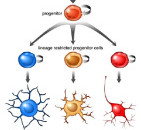Radial glial cells are a widespread non-neuronal cell type in the developing CNS of all vertebrates examined so far. They were first identified as a transient population that serves as a scaffold for neuronal migration; however, their fundamental role as neural progenitor cells has been well demonstrated in the past decade.
Radial glial cells are defined by their characteristic radial bipolar morphology and their astroglial properties. These long bipolar cells expand across the entire thickness of the developing neocortex with a long basal radial process pointing to the pial surface, a short apical ventricular endfoot reaching the ventricular zone surface, and the soma located in the ventricular zone.
During the early stages of neurogenesis, Radial glial cells largely divide symmetrically to produce two radial glial progenitor cells after each division.
At later stages, they predominantly undergo asymmetric cell division to self-renew and, at the same time, to generate a differentiating daughter cell that is either a neuron or an intermediate progenitor cell or an outer subventricular zone progenitor cell. At the end of neurogenesis, radial glial cells are shown to switch to gliogenesis producing astrocytes and oligodendrocytes.
- Part of Speech: noun
- Industry/Domain: Science
- Category: Basic science
Other terms in this blossary
Creator
- Barbara 60
- 100% positive feedback









